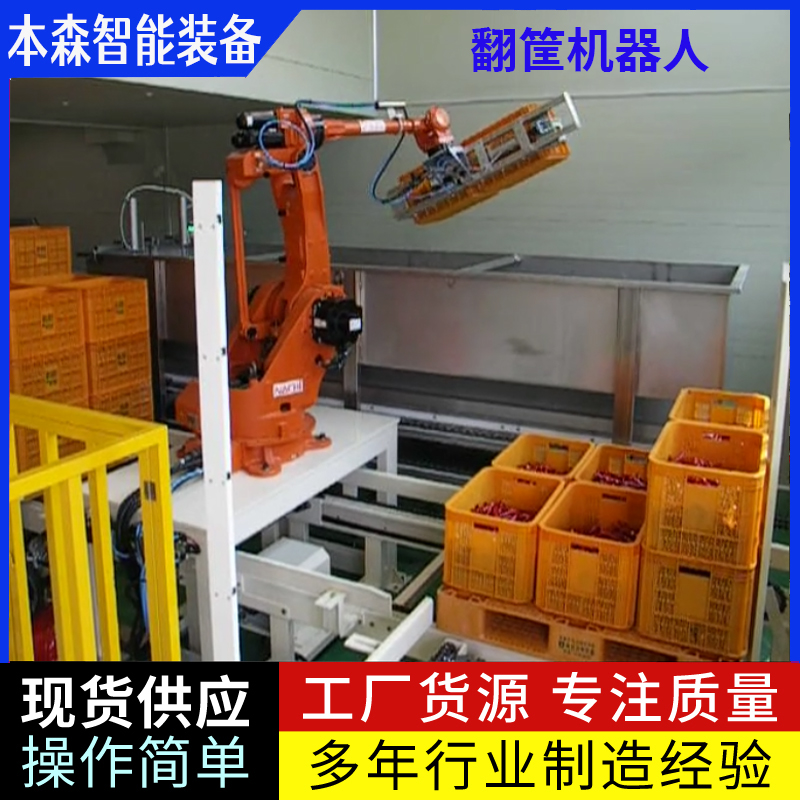
水果筐翻筐倒入機器人清洗流程是一種自動化或半自動化的水果筐清潔解決方案,旨在提高清洗效率、減少人力需求并保證清洗質(zhì)量。以下是一個簡化的流程描述,具體步驟可能會根據(jù)不同的設(shè)備制造商和設(shè)計要求有所差異: 1. 筐子準(zhǔn)備與上料 ? 手動或自動搬運 :操作員將待清洗的水果筐放置在指定的上料區(qū)域,或者通過輸送帶等自動化裝置自動送入。 ? 定位與固定 :筐子通過機械臂或定位裝置固定,確保在翻轉(zhuǎn)和轉(zhuǎn)移過程中穩(wěn)定。 2. 翻筐 ? 機械臂操作 :機器人配備的機械臂根據(jù)預(yù)設(shè)程序,精準(zhǔn)抓取筐子進(jìn)行180度翻轉(zhuǎn),使筐內(nèi)殘留物暴露出來準(zhǔn)備清洗。 ? 安全控制 :此過程需確保有適當(dāng)?shù)陌踩胧苊饪鹱踊浠驌p壞。 3. 傾倒殘留物 ? 傾倒設(shè)計 :翻轉(zhuǎn)后的筐子被移到特定的傾倒區(qū)域,通過輕微振動或傾斜設(shè)計,使筐內(nèi)的殘留果皮、葉子等自然脫落至收集容器中。 ? 殘留物處理 :收集的殘留物可進(jìn)一步處理,如用于堆肥等環(huán)保方式處置。 4. 清洗 ? 噴淋清洗 :筐子進(jìn)入清洗區(qū),高壓噴頭從不同角度噴射清水(或加入適量清洗劑的水)對筐內(nèi)外進(jìn)行全面清洗。 ? 循環(huán)用水系統(tǒng) :為節(jié)約水資源,現(xiàn)代清洗系統(tǒng)通常配備循環(huán)用水和過濾系統(tǒng),以去除水中雜質(zhì)并重復(fù)利用。 5. 消毒與干燥 ? 消毒 :清洗后,使用次氯酸鈉溶液或其他食品級消毒劑進(jìn)行消毒處理,確保筐子衛(wèi)生安全。 ? 熱風(fēng)干燥 :最后,筐子通過熱風(fēng)干燥區(qū),高溫?zé)犸L(fēng)快速蒸發(fā)水分,確保筐子干燥無菌,為下一輪使用做準(zhǔn)備。 6. 下料與堆放 ? 自動下料 :干燥后的筐子由機器人或輸送帶自動移出,放置到指定區(qū)域或直接返回生產(chǎn)線使用。 ? 質(zhì)量檢查 :可選步驟,人工或自動檢查筐子的清潔度,確保符合衛(wèi)生標(biāo)準(zhǔn)。 整個流程高度依賴于自動化技術(shù),包括機器人、傳感器、控制系統(tǒng)等,以實現(xiàn)高效、一致的清洗效果。不同類型的水果筐和清洗需求可能需要調(diào)整具體流程或設(shè)備配置。 The Fruit Basket Turning and Dumping Robotic Cleaning Process is an automated or semi-automated fruit basket cleaning solution designed to improve cleaning efficiency, reduce manpower requirements, and ensure cleaning quality. The following is a simplified description of the process, and the specific steps may vary depending on the device manufacturer and design requirements: 1. Basket preparation and loading ? Manual or automatic handling : The fruit basket to be washed is placed in a designated loading area by the operator, or automatically fed by an automated device such as a conveyor belt. ? Positioning and fixation : The basket is fixed by a robotic arm or positioning device to ensure stability during turning and transferring. 2. Turn over the basket ? Robotic arm operation The robotic arm equipped with the robot accurately grabs the basket and flips it 180 degrees according to the preset program, so that the residue in the basket is exposed and ready for cleaning. ? Security controls : This process ensures that appropriate safety measures are in place to prevent the basket from slipping or being damaged. 3. Dump the residue ? Pour design : The flipped basket is moved to a specific dumping area, and the remaining peels and leaves in the basket will naturally fall off into the collection container through slight vibration or tilting. ? Residue treatment : The collected residue can be further disposed of, e.g. for environmentally friendly disposal such as composting. 4. Washing ? Spray cleaning : When the basket enters the cleaning area, the high-pressure nozzle sprays clean water (or water with an appropriate amount of cleaning agent) from different angles to comprehensively clean the inside and outside of the basket. ? Recycled water system To conserve water, modern cleaning systems are often equipped with recycled water and filtration systems to remove impurities from the water and reuse it. 5. Disinfection and drying ?disinfect After cleaning, use sodium hypochlorite solution or other food-grade disinfectant for disinfection to ensure the hygiene and safety of the basket. ? Hot air drying Finally, the basket passes through the hot air drying zone, and the high-temperature hot air quickly evaporates the water to ensure that the basket is dry and sterile, ready for the next round of use. 6. Blanking and stacking ? Automatic unloading The dried basket is automatically removed by a robot or conveyor belt and placed in a designated area or returned directly to the production line. ? Quality checks : Optional step to manually or automatically check the cleanliness of the basket to ensure compliance with hygienic standards. The entire process is highly dependent on automation technology, including robots, sensors, control systems, and more, to achieve efficient and consistent cleaning results. Different types of fruit baskets and cleaning needs may require specific process or equipment configurations.
|


